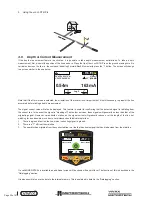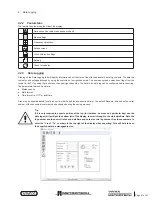
™
Page 26 of 67
3 Using the vLoc3 RTK-Pro
7. Rotate the vLoc3 RTK-Pro on its axis to obtain the maximum signal. The vLoc3 RTK-Pro is now directly over the line
and with the blade across the line. (If using the Omni-Peak mode there will be no change so switch to Peak mode if the
direction is required).
8. The direction can also be found by rotating until the smallest signal is detected. The blade is then in line with the cable/pipe.
9. Continue to locate the position of the line at regular intervals until its course is known through the target area.
3.2.2 Detecting Radio Signals
1. Locating radio signals is very similar to detecting power signals as they are both passive signals.
2. Hold the vLoc3 RTK-Pro vertically and away from likely positions of cables or pipes.
3. Adjust the sensitivity control so that the bar graph reading is just starting to show some movement. Now follow the
procedure described above in the power mode section.
3.3 Active Locating:- Applying the Transmitter
Active locating uses a transmitter to apply a precise frequency to a pipe or cable, then uses a receiver turned to detect the
signal being radiated at that precise frequency. Active location frequencies can be applied by direct connection, signal clamp, or
induction (This is further explained in the following sections).
Active locating has the benefit, unlike passive detecting, the operator is in control of the signals and therefore, can be more
specific about what line is detected. That is to say, active signals can be used for line tracing. Also, passive signals are not
always present on a line, so using active signals ensures more lines are detected.
Choosing the correct frequency will depend on the application, but as a general rule, select low frequencies as these tend to “bleed
off” less than higher frequencies. A good general-purpose frequency is 33kHz and is a good starting point if in doubt.
When using “induction” or the “signal clamp,” the frequencies available are limited to a set of frequencies optimized for the
equipment. The full range of frequencies is available in the “direct connection” mode.
For frequencies below 45 kHz, authorities such as the FCC allow higher power output to be used; for frequencies of 45 kHz and
above, power output for this type of equipment is restricted to 1 watt. Therefore more power is available when lower frequencies
are used.
To inject a signal requires the use of a transmitter. The signal can be injected or applied to the target line in a variety of ways.
3.3.1 Direct Connection
This method involves making an electrical connection to the cable or pipe.
WARNING
When connecting to a cable, only connect to the sheath of that cable. The direct connection leads are
not designed for connection to live cables.
WARNING
Do not touch metal parts of the connection clips when connecting to the line or when the transmitter
is on.
















































